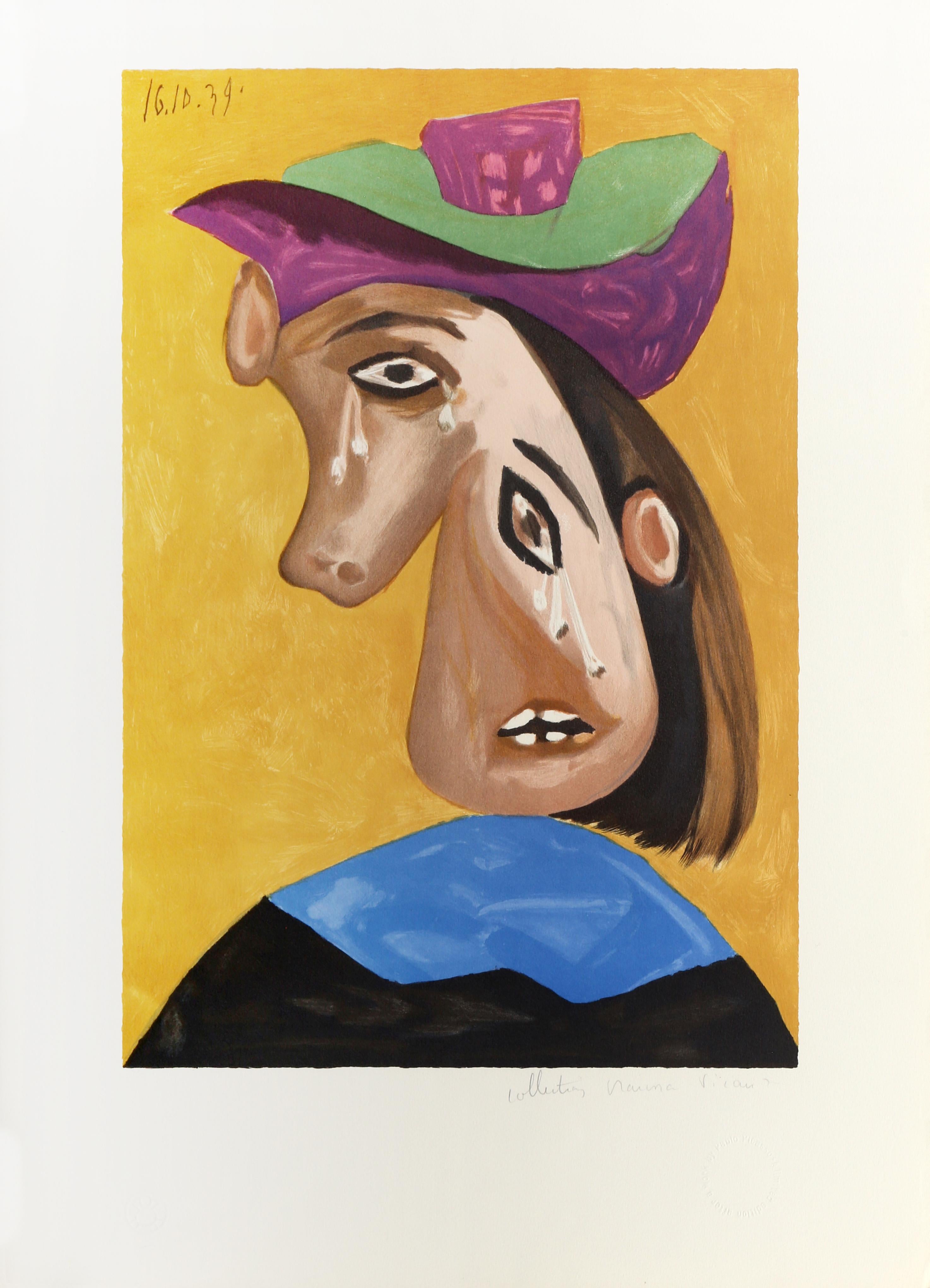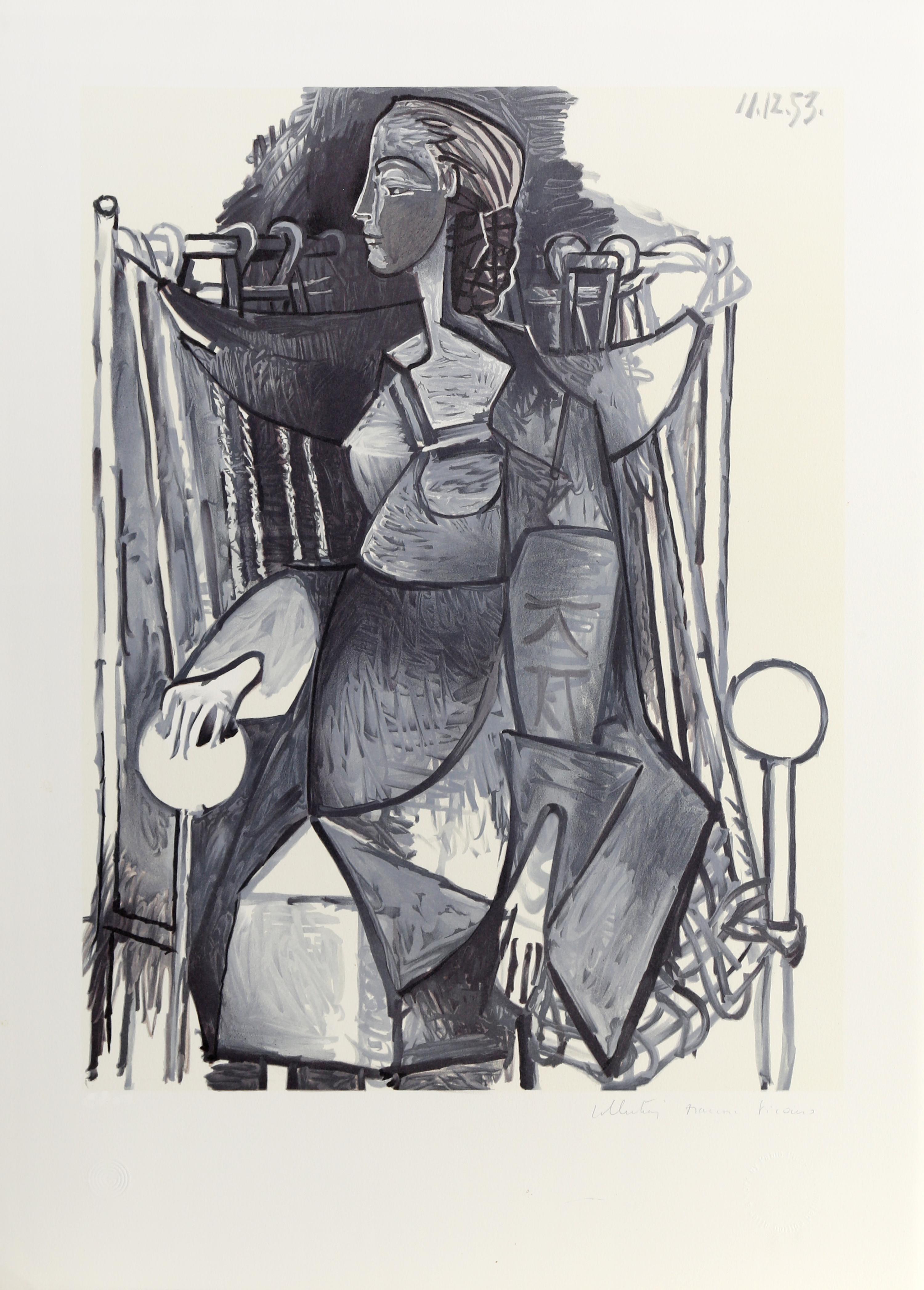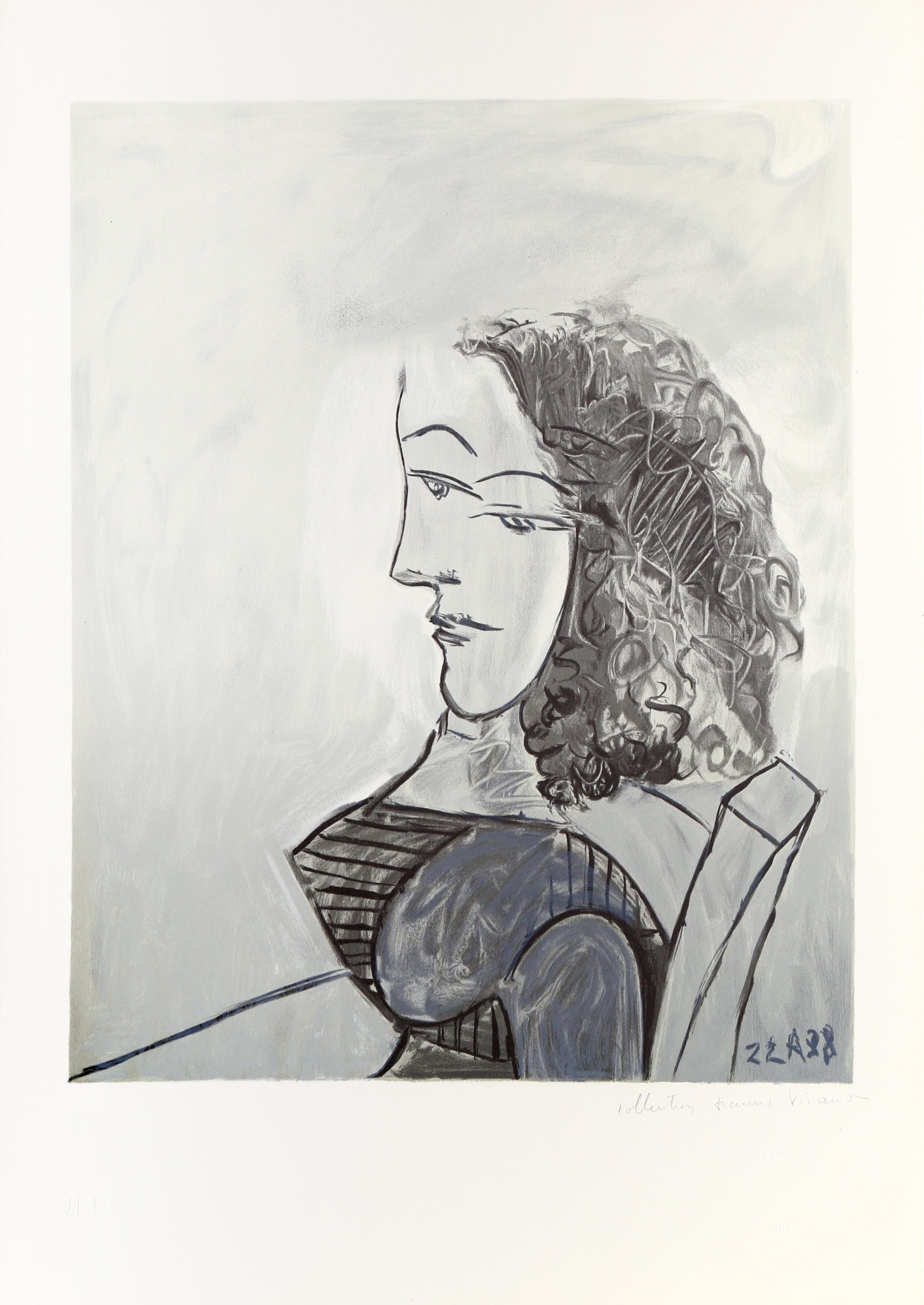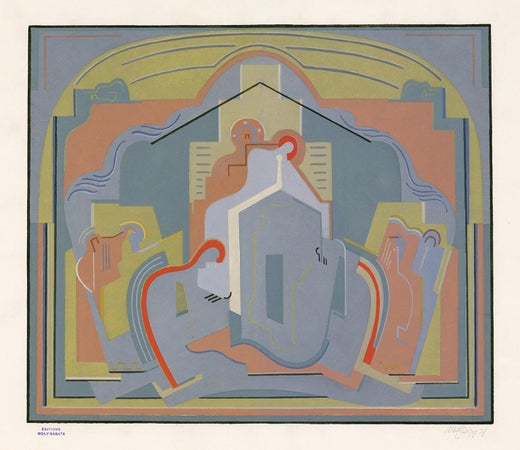Items Similar to 'Descente de Croix' (Descent from the Cross) — 1920s French Cubism
Want more images or videos?
Request additional images or videos from the seller
1 of 6
Albert Gleizes'Descente de Croix' (Descent from the Cross) — 1920s French Cubism1928
1928
About the Item
Albert Gleizes, 'Descente de Croix', color pochoir, 1928, edition c. 50. Signed and dated in pencil. A fine, painterly impression, with fresh colors, on heavy, cream wove paper; the full sheet with margins (3 to 4 inches), in very good condition. The publisher's ink stamp 'EDITIONS MOLY-SABATA' beneath the image, lower left. Matted to museum standards, unframed.
Image size 12 x 14 inches (305 x 356 mm); sheet size 18 x 22 inches (457 x 559 mm).
ABOUT THE IMAGE
After the 1927 painting 'Descente de Croix', one of three religious-themed works that Gleizes developed as preliminaries for murals at the church at Serrières, France, the project was terminated at its final phase, and Gleizes commissioned master printer Robert Pouyaud to create prints of the paintings, closely overseeing the production.
ABOUT THE MEDIUM
Pochoir is a refined stencil-based technique employed to create multiples or to add color to prints produced in other mediums. Characterized by its crisp lines and rich color, the print-making process was most popular from the late 19th century through the 1930s, with its center of activity in Paris. The pochoir process began with the analysis of an image’s composition, including color tones and densities. The numerous stencils (made of aluminum, copper, or zinc) necessary to create a complete image were then designed and hand-cut by the 'découpeur.' The 'coloristes' applied watercolor or gouache pigments through the stencils, skillfully employing a variety of different brushes and methods of paint application to achieve the desired depth of color and textural and tonal nuance. The pochoir process, by its handcrafted methodology, resulted in the finished work producing the effect of an original painting, and in fact, each print was unique.
ABOUT THE ARTIST
Albert Gleizes (1881-1953), born in Paris, France, was a pioneering figure in the development of abstract art and one of the leading proponents of Cubism. His contributions to the art world extended beyond his paintings; he was also a prolific writer and theoretician, advocating for a new approach to art that emphasized the geometric abstraction of form and a departure from representational traditions.
Gleizes initially studied painting at the Académie Julian and the École des Beaux-Arts in Paris, where he was exposed to the academic conventions of the time. However, his artistic vision was profoundly influenced by encounters with avant-garde movements, including Fauvism and the work of Paul Cézanne. These influences led Gleizes to experiment with form and color, gradually moving away from traditional representation toward a more abstract and geometric style.
After completing his secondary schooling, Gleizes spent four years in the French army and then began pursuing a career as a painter, primarily doing landscapes. Initially influenced by the Impressionists, he was only twenty-one years of age when his work titled ‘La Seine à Asnières’ was exhibited at the Société Nationale des Beaux-Arts in 1902. The following year, he was part of the first Salon d'Automne and soon came under the influence of Fernand Léger, Robert Delaunay, Jean Metzinger, and Henri Le Fauconnier. In 1907, Gleizes and some of his friends pursued the idea of creating a self-supporting community of artists that would allow them to develop their art free of any commercial concerns. For nearly a year, Gleizes , with other painters, poets, musicians, and writers, lived at a large house in Créteil, but a lack of funds forced them to give up their facility in early 1908, and Gleizes moved temporarily into La Ruche, the artist commune in the Montparnasse Quarter of Paris.
In the early 1910s, Gleizes became associated with the Cubist movement, which was spearheaded by artists such as Pablo Picasso and Georges Braque. Cubism sought to represent the multidimensional aspects of reality by breaking down forms into geometric shapes and exploring multiple perspectives within a single composition. Gleizes's contributions to Cubism were significant, as he co-authored the influential treatise "Du Cubisme" (On Cubism) with Jean Metzinger in 1912, outlining the principles and theories behind the movement.
With the outbreak of World War I, Albert Gleizes re-enlisted in the French army. He was put in charge of organizing entertainment for the troops and, as a result, was approached by Jean Cocteau to design the set and costumes for the William Shakespeare play, ‘A Midsummer Night's Dream.’ Discharged from the military in the fall of 1915, Gleizes and his new wife, Juliette Roche, the daughter of a prominent and wealthy French statesman, moved to New York City. From there, the couple sailed to Barcelona, Spain, where they were joined by Marie Laurencin, Francis Picabia, and his wife. The group spent the summer painting at the resort area of Tossa del Mar, and in December, Gleizes had the first solo exhibition of his works at the Galeries Dalmau in Barcelona. Returning to New York City, Gleizes began writing poetic sketches in verse and in prose. Traveling to Bermuda, he painted a number of landscapes, but when the war in Europe ended, he returned to France, where his career evolved into teaching through writing, and he became involved with the committee of the Unions Intellectuelles Françaises. In 1927, still dreaming of the communal days in Créteil, he founded an artist's colony at a rented house called the Moly-Sabata in Sablons near his wife's family home in Serrières in the Ardèche département in the Rhône Valley.
In 1931, Gleizes was part of the committee of Abstraction-Création that acted as a forum for international non-representational art. By this time, his work reflected the strengthening of his spiritual convictions, and his 1932 book, La Forme et l’histoire, examines Celtic, Romanesque, and Oriental art. On tour in Poland and Germany, he gave lectures titled Art et Religion, Art et Production, and Art et Science. In 1937, Gleizes was hired to paint murals for the Exposition Internationale des Arts et Techniques dans la Vie Moderne at the Paris World’s Fair. He collaborated with Delaunay in the Pavillon de l'Air and with Léopold Survage and Fernand Léger for the Pavillon de l'Union des Artistes Modernes. At the end of 1938, Gleizes volunteered to participate in the free seminars and discussion groups for young painters set up by Robert Delaunay at his Paris studio.
In the late 1930s, the wealthy American art connoisseur Peggy Guggenheim purchased a great deal of the new art in Paris, including works by Albert Gleizes. She brought these works to the United States, which today form part of the Peggy Guggenheim Collection. During World War II, Gleizes and his wife remained in France under the German occupation. His religious convictions deepened, and at the war's end, he was hailed by some as having laid out the principles for a renewal of religious art. In 1948, Gleizes accepted an offer from a publisher in Casablanca to create a series of etchings illustrating the ‘Pensées sur l'Homme et Dieu’ of Blaise Pascal. In 1951, he was made a jury member for the Prix de Rome, and the French government awarded him the Legion of Honor. In 1952, he completed his last major work, a fresco titled ‘Eucharist’ created for a Jesuit chapel in Chantilly.
Throughout his career, Gleizes remained dedicated to exploring the formal possibilities of abstraction while also incorporating elements of rhythm, color, and dynamic movement into his compositions. His style evolved over time, reflecting his ongoing engagement with modernist ideas and his interest in spirituality and metaphysics.
Albert Gelizes’ work is represented in numerous museums in the United States, the United Kingdom, and Europe including the British Museum (London), Los Angeles County Museum of Art, Musée d'Art Moderne de la Ville de Paris, Musée des Beaux-Arts de Lyon (Lyon, France), Musée de Grenoble (Grenoble, France), Musée National d'Art Moderne (Centre Georges Pompidou, Paris), Museum of Modern Art (New York), National Gallery of Art (Washington, D.C.), Peggy Guggenheim Collection (Venice, Italy), Solomon R. Guggenheim Museum (New York), The Metropolitan Museum of Art (New York), Philadelphia Museum of Art, Tate Modern (London).
- Creator:Albert Gleizes (1881-1953, French)
- Creation Year:1928
- Dimensions:Height: 12 in (30.48 cm)Width: 14 in (35.56 cm)
- Medium:
- Movement & Style:
- Period:
- Condition:
- Gallery Location:Myrtle Beach, SC
- Reference Number:
Albert Gleizes
Albert Gleizes (1881-1953) was a prominent French artist, theorist, and philosopher, best remembered as a pioneer of Cubism alongside artists like Picasso and Braque. Born in Paris, his early work was influenced by Impressionism, but by 1910, he had delved deep into the innovative world of Cubism, emphasizing geometrical forms and multiple viewpoints. With Jean Metzinger, he co-authored "On Cubism," a significant treatise that helped define and explain the movement's principles. Throughout his career, Gleizes continued to evolve his style, moving towards abstraction and integrating his fascination with rhythm and color. In addition to his visual contributions, his writings made him an influential voice in 20th-century art theory. A true visionary, Gleizes not only reshaped the art world with his creations but also laid the groundwork for future abstract artists with his profound insights into the essence of art.
About the Seller
5.0
Recognized Seller
These prestigious sellers are industry leaders and represent the highest echelon for item quality and design.
Platinum Seller
These expertly vetted sellers are 1stDibs' most experienced sellers and are rated highest by our customers.
Established in 1995
1stDibs seller since 2016
258 sales on 1stDibs
Typical response time: 1 hour
Associations
International Fine Print Dealers Association
- ShippingRetrieving quote...Ships From: Myrtle Beach, SC
- Return PolicyA return for this item may be initiated within 7 days of delivery.
More From This SellerView All
- Variation 4, Vol. IBy Katherine Sophie DreierLocated in Myrtle Beach, SCKatherine S. Dreier, 'Variation 4, Vol. I' from '1 to 40 Variations', lithograph with pochoir and hand-coloring, 1934, edition 65. Stenciled signature and date, lower right. Annotate...Category
Mid-20th Century American Modern Abstract Prints
MaterialsWatercolor, Lithograph, Stencil
- 'Variation 5, Vol. I' — from the series '1 to 40 Variations'By Katherine Sophie DreierLocated in Myrtle Beach, SCKatherine S. Dreier, 'Variation 5, Vol. I' from '1 to 40 Variations', lithograph with pochoir and hand-coloring, 1934, edition 65. Stenciled signature and date, lower right. Annotate...Category
Mid-20th Century American Modern Abstract Prints
MaterialsWatercolor, Lithograph, Stencil
- 'Counterpoint' — Modernist Abstraction, 1940sBy Edward August LandonLocated in Myrtle Beach, SCEdward Landon, 'Counterpoint', color serigraph, 1942, edition 25, Ryan 45. Signed, titled, and annotated 'Edition 25' in pencil. A fine impression, with fresh colors, on cream, wove paper; the full sheet with margins (7/8 to 2 1/2 inches). A 1 1/2 inch crease across the top left sheet corner, well away from the image, otherwise in excellent condition. Scarce. Image size 13 9/16 x 14 5/16 inches (344 x 364 mm); sheet size 14 15/16 x 17 inches (379 x 432 mm). Matted to museum standards, unframed. Literature: 'A Spectrum of Innovation: Color in American Printmaking', David Acton, New York, London, 1990. 'American Screenprints', Reba and Dave Williams, New York, 1987. 'The American Scene: Prints from Hopper to Pollock', Stephen Coppel, The British Museum, 2008. Impressions of this work are held in the following museum collections: Albright-Knox Art Gallery, National Gallery of Art, Smithsonian American Art Museum. ABOUT THE ARTIST Born in Hartford, Connecticut, Edward Landon dropped out of high school to study art at the Hartford Art School. In 1930 and 1931 he was a student of Jean Charlot at the Art Students League in New York, after which he traveled to Mexico to study privately for a year with Carlos Merida. In 1933 he settled near Springfield, Massachusetts, painted murals in the local trade school, and exhibited with the Springfield Art League. His painting 'Memorial Day' won first prize at the fifteenth annual exhibition of the League at the Springfield Museum of Fine Arts. Landon became an active member of the Artists Union of Western Massachusetts, serving as president from 1934-1938. Landon acquired Anthony Velonis’s instructional pamphlet on the technique of serigraphy in the late 1930s. With colleagues Phillip Hicken, Donald Reichert, and Pauline Stiriss, he began experimenting with screen printing techniques. The artists' groundbreaking work in screen printing as a fine art medium was the subject of the group’s landmark exhibition at the Springfield Museum of Fine Arts in 1940. Landon became one of the founding members of the National Serigraph Society and served as editor of its publication, 'Serigraph Quarterly,' in the late 1940s and as its president in 1952 and 1953. The Norlyst Gallery in Manhattan held a one-person show of his prints in 1945. Awarded a Fulbright Fellowship in 1950, Landon traveled to Norway, where he researched the history of local artistic traditions and produced the book 'Scandinavian Design: Picture and Rune Stones...Category
Mid-20th Century American Modern Abstract Prints
MaterialsScreen
- 'European Landscape' —Mid-century American SurrealismBy Lawrence KupfermanLocated in Myrtle Beach, SCLawrence Kupferman, 'European Landscape', drypoint, edition 50, 1942. Signed, dated, titled, and numbered '7/50' in pencil. A superb, finely nuanced impression, on cream wove paper; the full sheet with margins (1 to 1 3/4 inches); in excellent condition. Image size 10 7/8 x 13 3/8 inches; sheet size 13 1/8 x 16 1/2 inches. Archivally matted to museum standards, unframed. An impression of this work is included in the permanent collection of the Syracuse University Art Museum. ABOUT THE ARTIST Lawrence Kupferman (1909 - 1982) was born in the Dorchester neighborhood of Boston and grew up in a working-class family. He attended the Boston Latin School and participated in the high school art program at the Museum of Fine Arts, Boston. In the late 1920s, he studied drawing under Philip Leslie Hale at the Museum School—an experience he called 'stultifying and repressive'. In 1932 he transferred to the Massachusetts College of Art, where he first met his wife, the artist Ruth Cobb. He returned briefly to the Museum School in 1946 to study with the influential expressionist German-American painter Karl Zerbe. Kupferman held various jobs while pursuing his artistic career, including two years as a security guard at the Museum of Fine Arts, Boston. During the 1930s he worked as a drypoint etcher for the Federal Art Project, creating architectural drawings in a formally realistic style—these works are held in the collections of the Fogg Museum and the Smithsonian American Art Museum. In the 1940s he began incorporating more expressionistic forms into his paintings as he became progressively more concerned with abstraction. In 1946 he began spending summers in Provincetown, Massachusetts, where he met and was influenced by Mark Rothko, Hans Hofmann, Jackson Pollock, and other abstract painters. At about the same time he began exhibiting his work at the Boris Mirski Gallery in Boston. In 1948, Kupferman was at the center of a controversy involving hundreds of Boston-area artists. In February of that year, the Boston Institute of Modern Art issued a manifesto titled 'Modern Art and the American Public' decrying 'the excesses of modern art,' and announced that it was changing its name to the Institute of Contemporary Art (ICA). The poorly conceived statement, intended to distinguish Boston's art scene from that of New York, was widely perceived as an attack on modernism. In protest, Boston artists such as Karl Zerbe, Jack Levine, and David Aronson formed the 'Modern Artists Group' and organized a mass meeting. On March 21, 300 artists, students, and other supporters met at the Old South Meeting House and demanded that the ICA retract its statement. Kupferman chaired the meeting and read this statement to the press: “The recent manifesto of the Institute is a fatuous declaration which misinforms and misleads the public concerning the integrity and intention of the modern artist. By arrogating to itself the privilege of telling the artists what art should be, the Institute runs counter to the original purposes of this organization whose function was to encourage and to assimilate contemporary innovation.” The other speakers were Karl Knaths...Category
1940s Surrealist Abstract Prints
MaterialsDrypoint
- 'Salient in February' — Mid 20th-Century SurrealismBy Edward August LandonLocated in Myrtle Beach, SCEdward Landon 'Salient in February', color serigraph, 1945, edition 40, Ryan 166. Signed in pencil. Titled, dated, and annotated 'ED. 40' in pencil. A fine impression, with fresh col...Category
Mid-20th Century Surrealist Abstract Prints
MaterialsScreen
- 'Green Shade' — Mid-century Modernism, Abstract Expressionism, Atelier 17By Stanley William HayterLocated in Myrtle Beach, SCStanley William Hayter, 'Green Shade', color etching and scraper, 1963, edition 50, (only 39 printed), B&M 278. Signed, titled, dated, and numbered '1/50' in pencil. A superb, richly-inked, luminous impression, with fresh, vivid colors, on Barcham Green textured cream wove paper; the full sheet with margins (2 3/16 to 3 1/4 inches), in excellent condition. Printed: intaglio black-green, contact lumogen yellow, soft roller phthalo green. Scarce. Image size 15 7/16 x 11 5/8 inches (392 x 295 mm); sheet size 21 1/8 x 16 inches (537 x 406 mm). Matted to museum standards (unframed). Collection: The British Museum ABOUT THE ARTIST Stanley William Hayter (1901-1988) was a British painter and printmaker associated in the 1930s with Surrealism and from 1940 onward with Abstract Expressionism. Regarded as one of the most significant printmakers of the 20th century, Hayter founded the legendary Atelier 17...Category
1960s Abstract Expressionist Abstract Prints
MaterialsEtching
You May Also Like
- Femme et Enfant EnlacesBy Pablo PicassoLocated in Long Island City, NYPablo Picasso's mastery of perspective and creativity regarding subject matter can be witnessed in this print. Integrating the classic theme of mothers and their children into the av...Category
Late 20th Century Cubist Abstract Prints
MaterialsLithograph
- Le PleureuseBy Pablo PicassoLocated in Long Island City, NYIn this dramatic print by Pablo Picasso, the artist has rendered a figure in mourning using several different perspectives and angles. Portrayed wth two tears streaming from the left...Category
Late 20th Century Cubist Abstract Prints
MaterialsLithograph
- Petite Fille a la Robe Verte (Paloma Picasso)By Pablo PicassoLocated in Long Island City, NYPablo Picasso's portrait of his daughter Paloma relies on abstracted perspectives and dramatic angles. The artist's combination of smooth, flowing lines and harsh, abrupt angles crea...Category
Late 20th Century Cubist Abstract Prints
MaterialsLithograph
- Portrait de Femme Assise, Robe VerteBy Pablo PicassoLocated in Long Island City, NYSitting in a chair and wearing a green dress, the woman in this Pablo Picasso print is reduced to a series of geometric shapes. Her figure is fragmented into triangles and quadrilate...Category
Late 20th Century Cubist Abstract Prints
MaterialsLithograph
- Femme Assise dans un Fauteuil TresseBy Pablo PicassoLocated in Long Island City, NYSitting in a large armchair, the woman in this Pablo Picasso portrait looks to her left while she reclines. Comprised of shapes and lines, the figure of the woman is fragmented and s...Category
Late 20th Century Cubist Abstract Prints
MaterialsLithograph
- Femme aux Cheveux BouclésBy Pablo PicassoLocated in Long Island City, NYThis print by Pablo Picasso is representative of his forays into the manipulation of perspective regarding the depiction of faces. Showing a woman seated for a portrait in profile, t...Category
Late 20th Century Cubist Abstract Prints
MaterialsLithograph
Recently Viewed
View AllMore Ways To Browse
The Terminator
New York City 1920s
Crosses From Italy
Antique French Cross
Large Antique Cross
French Quarter Art
Cross 1920
Antique Stencil
Antique Stencils
Cubist Family
William Cross
Church Cross
Copper Cross
French Color Print 19th Century
1920s Spanish And French Paintings
The Worlds Religions Book
Antique Religious Art Prints
World Exposition Book






